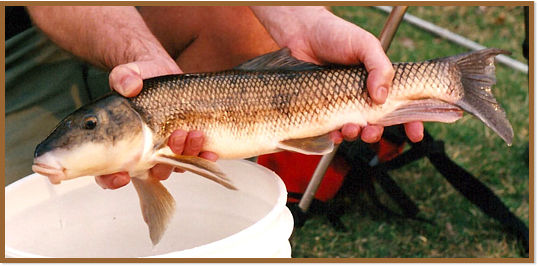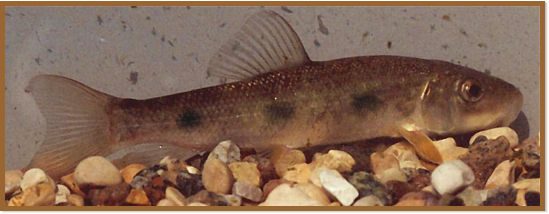
Biology of the White Sucker (Catostomus commersoni)
Some Background on Suckers |
(Click links to see images.) |
Suckers are a family of freshwater fishes (the Catostomidae) that includes about 65 species worldwide, with most of these in North America. They're all fairly robust or stout fishes, with species ranging in size from small (about 15 cm) to large (up to 45 cm) in length. Nearly all species in the family have the characteristic downward-pointing "sucker" mouth.
In Manitoba, there are 7 species of suckers, but the White Sucker is by far the most common.
Description
The White Sucker is best described as having a "torpedo shaped" body.

It has a broad, rounded head with a prominent downward-pointing, sucker-like mouth. It's body is cylindrical and is covered with large prominent scales. All its fins are broad with thick rays within. The tail is broad and moderately forked. The colour of adult fish varies a lot over their North American range. In Manitoba, they're usually light brown, grey or coppery coloured on top and creamy white on the belly. When the fish are spawning, their colours are darker and more intense. The males develop a distinct lateral, cream coloured band. After spawning their colours fade and the banding disappears. Outside of the breeding season, the sexes are hard to distinguish (as with most fish). Adult fish grow to as much as 50 cm in length, and regularly weigh in at 1 kg or more Reports of fish up to 2.5 kg have been made.
Young White Suckers, up to about 10 cm in size, are light brown or beige coloured and have three, very distinct, dark spots on their sides: one behind the gill plate, another about mid body and the third before the tail.

Classification
Here's the scientific classification of the White Sucker:
Kingdom: |
Animalia |
Name Derivation
Scientific Name: "Catostomus" is from the Greek, "kata", meaning downward, and the Greek "stoma", meaning mouth. So "Catostomus" is clearly a reference to the downward pointing mouth of a sucker. The specific name, "commersonii" is from the fish being named for an early French naturalist: Philibert Commerson. (Thanks go to Adam Labatore, for pointing this out!)
Distribution
The White Sucker is distributed throughout much of North America. It occurs almost everywhere in Manitoba, except in a small region of the extreme north of the province.
Distribution of the White Sucker in
North America (after Scott & Crossman 1973).
Habitat
The preferred habitat of this fish species seems to be shallow lakes, or the shallower bays of deeper lakes, and slow moving rivers, but they regularly occur in a wide range of aquatic habitats. Spawning migrations can bring suckers into very small tributaries of rivers or lakes, where, on occasion, they may become stranded in small pools or the upper reaches of small streams.
Winnipeg's Sturgeon
Creek
Site of an urban spawning run.
Habits
White suckers seem to be crepuscular in their activity; that is, they are most active around dawn and dusk, searching for food at these times. Fry and young suckers will stick together in large schools and will associate with other species that are similar sized to form mixed schools. Adult suckers travel in small schools, moving around in the shallows of lakes or rivers. I couldn't find out much else about their activities or overwintering habits. Any information out there?
Food
White suckers, as you shouldn't be surprised to learn, are bottom feeders. They suck up all sorts of creatures that they find on the bottom, including insects (mainly insect larvae), crustaceans (amphipods and cladocerans), molluscs (snails and small clams) and annelids (worms and leeches). Suckers just "hoover" up their food and swallow it, they have no teeth.
The fry of White Suckers eat plankton and other tiny invertebrates until they are about 15 mm long. Up to this size their mouths still point forward to accommodate catching food up in the water column. Once they reach 15 mm, their mouths rotate downward and they switch to the adult habit of bottom feeding.
White Suckers as Food!
White suckers have a vast host of predators, largely because they are often one of the most abundant fish species in lakes and rivers. As such they are often a major step on the way up the aquatic food chain. Suckers are preyed upon by many predatory fishes: pike, bass, walleye and others. Young suckers are eaten by birds such as cormorants, loons, kingfishers and herons. Ospreys and bald eagles take their share of suckers, too. Adult suckers exposed during their spawning runs in small streams can be eaten by raccoons, bears, wolves or other large predators.
And finally, at the top of the food chain (as usual) are people. Dip netting for suckers during their spawning runs is a common practice. The flesh of suckers is said to be white, sweet and flaky (haven't tried them myself). Lots of small bones are a drawback, though. They're supposed to be really good canned or smoked. There isn't much of a commercial market for suckers, though they can be found in stores as "mullet" occasionally. A lot of the commercial catch likely goes to processing for animal feed.
You can catch suckers by still-fishing with worms, minnows, salmon eggs or even a dough ball for bait. They're reported to be good fighters. Most fishermen are more familiar with suckers as bait rather than as the quarry. Young suckers are commonly sold as "bait minnows".
Populations
Anybody out there know how many suckers there could be in a given hectare of lake or river? I wasn't able to find any statistics on their populations. It's accepted that these fish are very common, but how common is common? I'd like to know.
Life Cycle
White suckers spawn in spring, anywhere from late April to early June in southern Manitoba, later further north, of course. Migration into spawning streams is triggered when the streams first reach about 10o C. Many thousands of suckers may enter even a small stream. They will spawn along the edges of lakes if no streams are available. Adult suckers will "home" to the stream where they were born. Spawning occurs in shallow water with a gravelly or rocky bottom. They will even spawn in riffles if this is the only gravelly site in a stream.
Riffles in Sturgeon Creek.
At a spawning site several males may crowd around one female. Their contact stimulates her to lay her eggs and the males, in turn, fertilize the eggs by releasing their milt. The eggs just sink into the gravel, no nest is constructed. The female releases her eggs in a few to many short bursts over an hour or more. Each female may lay from 20,000 to over 100,000 eggs! The adults leave the spawning grounds after a week or two, returning to the lake or river they originally came from. Adult suckers may live to be more than 15 years of age and return to spawn annually throughout their life.
The eggs hatch in about 2 weeks and the fry spend another couple of weeks in the gravel of the spawning grounds, feeding off their yolk sacks. Then they begin to swim around and forage, and move downstream to the lake or river their parents came from. Sucker fry can reach about 5 cm in length by the fall of their first year. They are fairly slow growing, though, and may take 3 or 4 years to reach spawning size.
Final Thoughts
I think White Suckers were the first large fish I ever encountered in the wild, if you can call the tiny trickle of Winnipeg's Omand's Creek, "in the wild". They opened my eyes to the importance of even the smallest stream, even one in the midst of an urban jungle, as habitat for wildlife. For there, in a shallow riffle in that tiny creek, these large fish spawned and perpetuated their species. No part of this land and no piece of habitat is so small as to be insignificant.
Acknowledgements
Some of the information in this article was drawn from the following sources:
Books
Freshwater Fishes of Canada. 1973. W. B. Scott and E. J. Crossman. Fisheries Research Board of Canada, Ottawa, Ont. Bulletin 184.
Notes on Warm Water Fish and Their Use. Manitoba Natural Resources, Fisheries. (Brochure)
Thanks for learning about White Suckers! Bye for now!
| You can help NatureNorth produce more great articles with a secure donation through PayPal. Our Google Adsense ads pay our server costs, but that's about it. To learn more follow this link: Support NatureNorth. Thank-you! | |
Return to: Spring Issue | NatureNorth Front page

